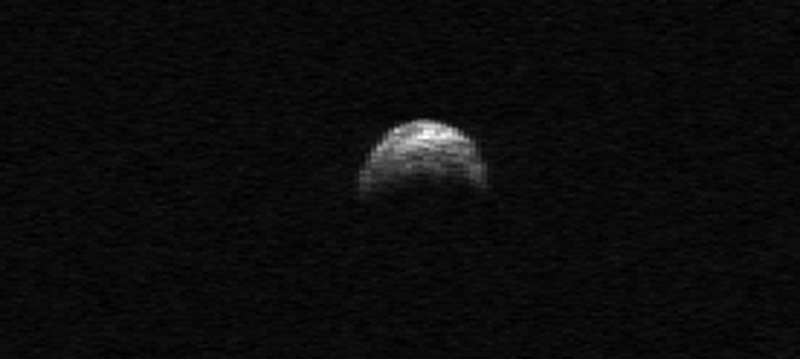Potentially Dangerous Asteroid Spotted Passing Earth

This story was updated at 5:49 a.m. ET on April 30.
An asteroid on the list of potentially dangerous space rocks that could endanger the Earth was caught on camera as it zoomed past our planet this month, and found to be larger than astronomers originally thought.
The asteroid buzzed the Earth on April 19 and came within 1.5 million miles (2.4 million km) of the planet. That's about six times the distance between Earth and the moon.
Astronomers used the planetary radar system on the famed Arecibo radio telescope in Arecibo, Puerto Rico to spot the asteroid, called 2005 YU55, over four days starting on April 19. The photo revealed the asteroid as a half-lit space rock flying through the solar system.
"At one time we had classified 2005 YU55 as a potential threat," said Steve Chesley, a scientist with NASA's Near-Earth Object Program Office at the Jet Propulsion Laboratory in Pasadena, Calif. [More asteroid photos.]
Chesley said the new Arecibo observations have allowed astronomers to rule out any chance of 2005 YU55 hitting Earth in the next 100 years. Additional observations will help better refine those projections, he said.
The Arecibo observations revealed some unexpected new details about the nearby space rock.
Get the Space.com Newsletter
Breaking space news, the latest updates on rocket launches, skywatching events and more!
The astronomers found that the asteroid is about 1,300 feet (400 meters) in size ? about a quarter-mile (400 meters) long and twice as big as originally thought. The Arecibo telescope's planetary radar system resolved features on the asteroid down to about 25 feet (7.5 meters).
Asteroid 2005 YU55 was first discovered by astronomer Robert McMillan, of the Spacewatch detection team, on Dec. 28, 2005. And this isn't the only chance astronomers will have to study 2005 YU55.
The space rock will be back.
On Nov. 8, 2011, the asteroid will complete another trip around the sun and swing by Earth again just inside the moon's orbit. It should fly by at a distance of 191,120 miles (307,577 km), about eight-tenths the distance between Earth and the moon. The distance from Earth to the moon is on average about 238,900 miles (384,472 km).
The asteroid poses no risk of impacting the Earth when it returns next year, though astronomers will keep watching its path through space.
NASA routinely tracks asteroids and comets that may fly near the Earth with a network of telescopes on the ground and in space. The agency's Near-Earth Object Observations program is responsible for finding potentially dangerous asteroids and studying their orbits to determine if they pose a risk of hitting the Earth.
So far, the program has found about 85 percent of the huge asteroids that fly near Earth, but it hasn't been quite as good at finding rocks that are smaller. The program detected only 15 percent of space rocks that are 460-feet (140-meters) wide and could potentially cause widespread devastation at their impact sites if they hit us, according to a recent report by the National Academy of Sciences.
Only 5 percent of asteroids 164-feet (50-meters) across have been found, the report found. More funding is needed if NASA hopes to reach a Congress-mandated goal of tracking all potentially dangerous space rocks.
President Barack Obama has proposed a budget increase in NASA's asteroid-tracking program that would boost its resources from $3.7 million in 2009 to $20.3 million in 2011. The program received a $2 million increase in 2010 to support the Arecibo telescope.
Obama has also proposed sending astronauts to visit an asteroid by 2025 to study it and gather data that could help astronomers find ways to deflect space rocks before they threaten all life on Earth.
The Arecibo Observatory is part of the National Astronomy and Ionosphere Center which is managed by Cornell University under a deal with the National Science Foundation. Astronomers with Cornell, NASA's Jet Propulsion Laboratory, California Institute of Technology and the University of Maine participated in the observing of asteroid 2005 YU55.
- Images - Asteroids Up Close
- Gallery - Earth's Meliteor Craters
- NASA's New Asteroid Mission Could Save the Planet
Join our Space Forums to keep talking space on the latest missions, night sky and more! And if you have a news tip, correction or comment, let us know at: community@space.com.

Space.com is the premier source of space exploration, innovation and astronomy news, chronicling (and celebrating) humanity's ongoing expansion across the final frontier. Originally founded in 1999, Space.com is, and always has been, the passion of writers and editors who are space fans and also trained journalists. Our current news team consists of Editor-in-Chief Tariq Malik; Editor Hanneke Weitering, Senior Space Writer Mike Wall; Senior Writer Meghan Bartels; Senior Writer Chelsea Gohd, Senior Writer Tereza Pultarova and Staff Writer Alexander Cox, focusing on e-commerce. Senior Producer Steve Spaleta oversees our space videos, with Diana Whitcroft as our Social Media Editor.